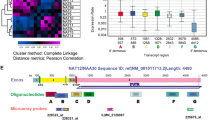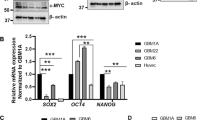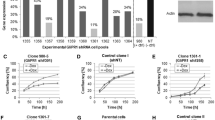Abstract
Neurodegeneration and brain edema are hallmarks of human malignant brain tumors. Here we show that genetic or pharmacological inhibition of the glutamate transporter xCT (Xc− system, encoded by SLC7a11) in vivo leads to abrogated neurodegeneration, attenuated perifocal edema and prolonged survival. These results show a crucial role for xCT in glioma-induced neurodegeneration and brain edema, corroborating the concept that edema formation may be in part a consequence of peritumoral cell death.


Similar content being viewed by others
References
DeAngelis, L.M. N. Engl. J. Med. 344, 114–123 (2001).
Hanahan, D. & Weinberg, R.A. Cell 100, 57–70 (2000).
Maher, E.A. et al. Genes Dev. 15, 1311–1333 (2001).
Papadopoulos, M.C. et al. Neuroscience 129, 1011–1020 (2004).
Wick, W. & Kuker, W. Onkologie 27, 261–266 (2004).
Jain, R.K. et al. Nat. Rev. Neurosci. 8, 610–622 (2007).
Takano, T. et al. Nat. Med. 7, 1010–1015 (2001).
Ye, Z.C. & Sontheimer, H. Cancer Res. 59, 4383–4391 (1999).
Sato, H. et al. J. Biol. Chem. 280, 37423–37429 (2005).
Shih, A.Y. et al. J. Neurosci. 26, 10514–10523 (2006).
Patel, S.A. et al. Neuropharmacology 46, 273–284 (2004).
Chung, W.J. et al. J. Neurosci. 25, 7101–7110 (2005).
Ishiuchi, S. et al. J. Neurosci. 27, 7987–8001 (2007).
Ishiuchi, S. et al. Nat. Med. 8, 971–978 (2002).
Verkman, A.S. et al. Biochim. Biophys. Acta 1758, 1085–1093 (2006).
Acknowledgements
We thank N. Scheufler, J. Csupor, S. Seufert, R. Schneider and H. Hilkman for experimental support. We further thank P.W. Kalivas (Medical University of South Carolina, Charleston, USA) for the antibody to xCT antibody and for sharing unpublished data, M. Conrad (German Research Center for Environmental Health, München, Germany) for the human and mouse xCT expression constructs, B.I. Kanner (Hebrew University Jerusalem, Israel) and G. Pietrini (Consiglio Nazionale delle Ricerche, Milano, Italy) for the GLT-1 expression construct and H. Sontheimer for providing details on the glutamate estimation. We acknowledge F. Mouttet and D. Peleg-Raibstein for technical support. We gratefully acknowledge members of M. Schwab's laboratory, J.R. Halstead and members of the H3 lab for helpful comments on the manuscript. E.H. is supported by the Köln Fortune Program of the Medical Faculty University Cologne and the Wilhelm Sander-Stiftung (WSS 2008.010.1). This study was funded by The International Human Frontiers Science Program Organization (to N.E.S.) and the Wilhelm Sander-Stiftung (WSS 2005.089.1 to I.Y.E.).
Author information
Authors and Affiliations
Contributions
N.E.S. and I.Y.E. conceived and designed the experiments; N.E.S., A.H., E.H. and I.Y.E. performed the in vitro experiments and contributed to the molecular cloning; N.E.S., T.E. and I.Y.E. performed the in vivo experiments; N.E.S., E.H., A.D., O.G., C.N., M.B. and I.Y.E. analyzed the data and contributed to techniques and analysis systems; N.E.S. and I.Y.E. wrote and edited the manuscript.
Corresponding authors
Supplementary information
Supplementary Text and Figures
Supplementary Figs. 1–5 and Supplementary Methods (PDF 682 kb)
Rights and permissions
About this article
Cite this article
Savaskan, N., Heckel, A., Hahnen, E. et al. Small interfering RNA–mediated xCT silencing in gliomas inhibits neurodegeneration and alleviates brain edema. Nat Med 14, 629–632 (2008). https://doi.org/10.1038/nm1772
Received:
Accepted:
Published:
Issue Date:
DOI: https://doi.org/10.1038/nm1772
- Springer Nature America, Inc.
This article is cited by
-
The Role of Brain Vasculature in Glioblastoma
Molecular Neurobiology (2019)
-
The ferroptosis inducer erastin irreversibly inhibits system xc− and synergizes with cisplatin to increase cisplatin’s cytotoxicity in cancer cells
Scientific Reports (2018)
-
ATF4 promotes angiogenesis and neuronal cell death and confers ferroptosis in a xCT-dependent manner
Oncogene (2017)
-
Chemotherapeutic xCT inhibitors sorafenib and erastin unraveled with the synaptic optogenetic function analysis tool
Cell Death Discovery (2017)
-
Nrf2-Keap1 pathway promotes cell proliferation and diminishes ferroptosis
Oncogenesis (2017)





